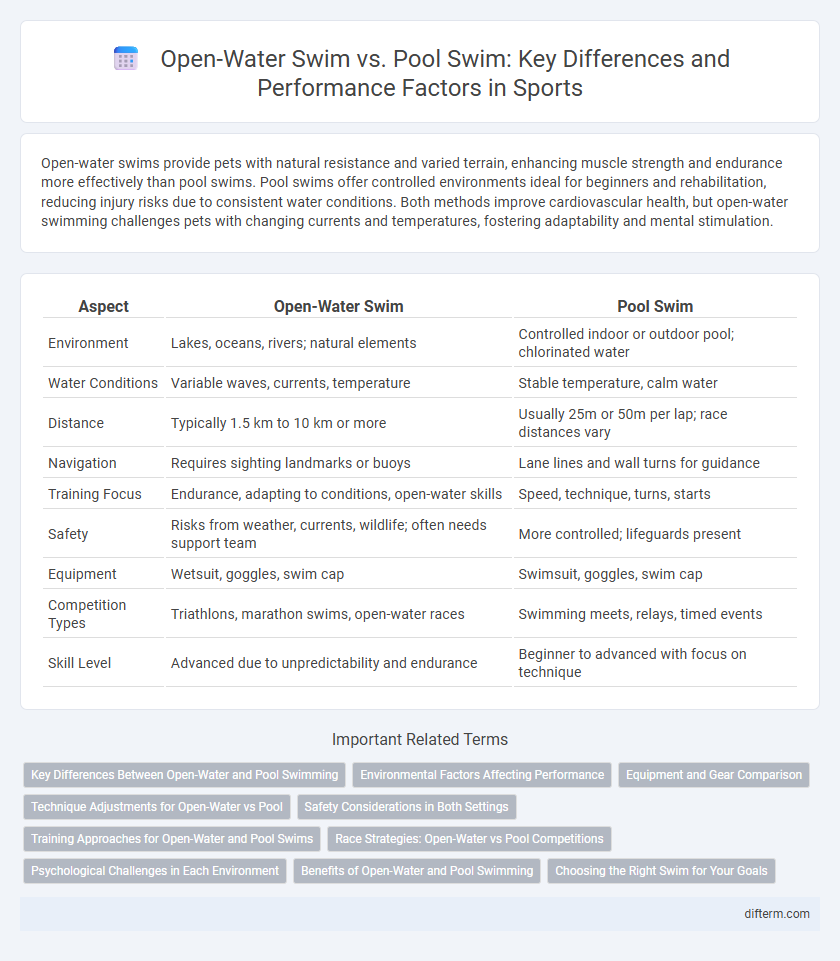Open-water swims provide pets with natural resistance and varied terrain, enhancing muscle strength and endurance more effectively than pool swims. Pool swims offer controlled environments ideal for beginners and rehabilitation, reducing injury risks due to consistent water conditions. Both methods improve cardiovascular health, but open-water swimming challenges pets with changing currents and temperatures, fostering adaptability and mental stimulation.
Table of Comparison
| Aspect | Open-Water Swim | Pool Swim |
|---|---|---|
| Environment | Lakes, oceans, rivers; natural elements | Controlled indoor or outdoor pool; chlorinated water |
| Water Conditions | Variable waves, currents, temperature | Stable temperature, calm water |
| Distance | Typically 1.5 km to 10 km or more | Usually 25m or 50m per lap; race distances vary |
| Navigation | Requires sighting landmarks or buoys | Lane lines and wall turns for guidance |
| Training Focus | Endurance, adapting to conditions, open-water skills | Speed, technique, turns, starts |
| Safety | Risks from weather, currents, wildlife; often needs support team | More controlled; lifeguards present |
| Equipment | Wetsuit, goggles, swim cap | Swimsuit, goggles, swim cap |
| Competition Types | Triathlons, marathon swims, open-water races | Swimming meets, relays, timed events |
| Skill Level | Advanced due to unpredictability and endurance | Beginner to advanced with focus on technique |
Key Differences Between Open-Water and Pool Swimming
Open-water swimming involves natural bodies of water such as lakes, oceans, and rivers, presenting unpredictable conditions like currents, waves, and varying temperatures, whereas pool swimming occurs in controlled environments with standardized dimensions and consistent water quality. Open-water swimmers must navigate buoys and adapt to outdoor elements, demanding heightened spatial awareness and endurance, while pool swimmers rely on lane lines, walls for turns, and regulated climates to optimize technique and speed. Training for open-water swimming emphasizes adaptability and mental resilience, contrasting with pool swimming's focus on precision, pacing, and stroke efficiency.
Environmental Factors Affecting Performance
Open-water swim performance is influenced by variable environmental factors such as water temperature, currents, waves, and water quality, which can affect buoyancy, resistance, and swimmer endurance. In contrast, pool swim occurs in controlled conditions with regulated temperature, calm water, and lane markings, promoting consistent performance outcomes. Understanding these environmental differences is crucial for training strategies and race preparation in competitive swimming.
Equipment and Gear Comparison
Open-water swimming requires specialized gear such as wetsuits designed for thermal insulation and buoyancy, open-water swim goggles with anti-fog and UV protection, and brightly colored swim caps for visibility and safety in natural environments. In contrast, pool swimming typically involves minimal equipment, primarily standard swimwear and streamlined goggles optimized for clear indoor water conditions. Open-water swimmers also often use safety buoys and waterproof GPS devices, which are unnecessary for pool swimmers due to the controlled setting.
Technique Adjustments for Open-Water vs Pool
Open-water swimming requires adapting stroke technique to accommodate waves, currents, and variable visibility, demanding a higher emphasis on sighting and bilateral breathing. Swimmers often employ a higher elbow catch and a more compact stroke to maintain efficiency in unpredictable conditions, contrasting with the streamlined, consistent rhythm favored in pool swimming. Efficient pacing and energy management become critical in open water, where environmental factors continuously challenge traditional pool stroke mechanics.
Safety Considerations in Both Settings
Open-water swimming requires heightened safety measures due to unpredictable conditions such as currents, temperature fluctuations, and limited visibility, necessitating the use of swim buoys and spotters. Pool swimming offers a controlled environment with consistent water quality, lifeguard supervision, and clear boundaries, reducing the risk of accidents or hypothermia. Both settings demand swimmers to wear appropriate gear, stay hydrated, and understand their physical limits to prevent injuries and ensure safe practice.
Training Approaches for Open-Water and Pool Swims
Open-water swim training emphasizes adapting to variable conditions such as currents, waves, and water temperature, incorporating sighting drills and endurance sets in natural bodies of water. Pool swim training prioritizes controlled environments, focusing on technique refinement, interval training, and consistent pacing to improve stroke efficiency and speed. Athletes targeting open-water events often blend both approaches, balancing technical skills with environmental acclimatization to optimize performance.
Race Strategies: Open-Water vs Pool Competitions
Open-water swim races require adaptive strategies due to variable conditions such as currents, waves, and temperature fluctuations, demanding constant navigation and drafting skills to conserve energy. Pool swim competitions emphasize precise pacing, flip turns, and stroke technique optimization within controlled environments to maximize speed and efficiency. Understanding these distinct tactical approaches is crucial for competitive swimmers to excel in their respective race formats.
Psychological Challenges in Each Environment
Open-water swimming presents unique psychological challenges such as managing anxiety related to unpredictable weather conditions, waves, and the absence of clear boundaries, which can significantly impact concentration and performance. In contrast, pool swimming offers a controlled environment that minimizes uncertainty but may induce pressure from lane competitions and repetitive laps, requiring mental endurance and focus. Both environments demand tailored psychological strategies to enhance resilience, adaptability, and sustained motivation during training and races.
Benefits of Open-Water and Pool Swimming
Open-water swimming enhances endurance and muscle strength by challenging swimmers with natural elements such as currents and waves, promoting greater adaptability and mental resilience. Pool swimming offers controlled conditions ideal for technique refinement, speed training, and consistent practice with precise lap tracking. Both disciplines contribute significantly to cardiovascular health, full-body conditioning, and overall swimming proficiency.
Choosing the Right Swim for Your Goals
Open-water swimming builds endurance and adapts swimmers to unpredictable conditions such as currents and varying water temperatures, ideal for those aiming to compete in triathlons or long-distance events. Pool swimming offers controlled environments that allow for precise technique refinement and interval training, benefiting athletes focused on speed and stroke efficiency. Evaluating whether your goals prioritize endurance or technical skill development will help determine the appropriate swim setting.
open-water swim vs pool swim Infographic

 difterm.com
difterm.com